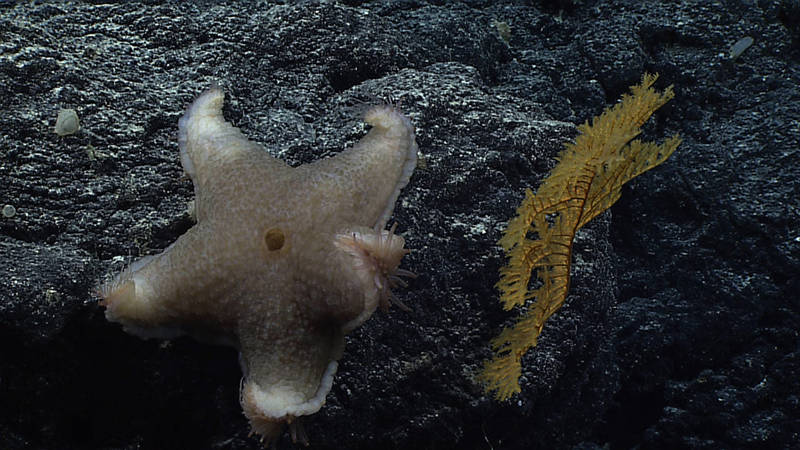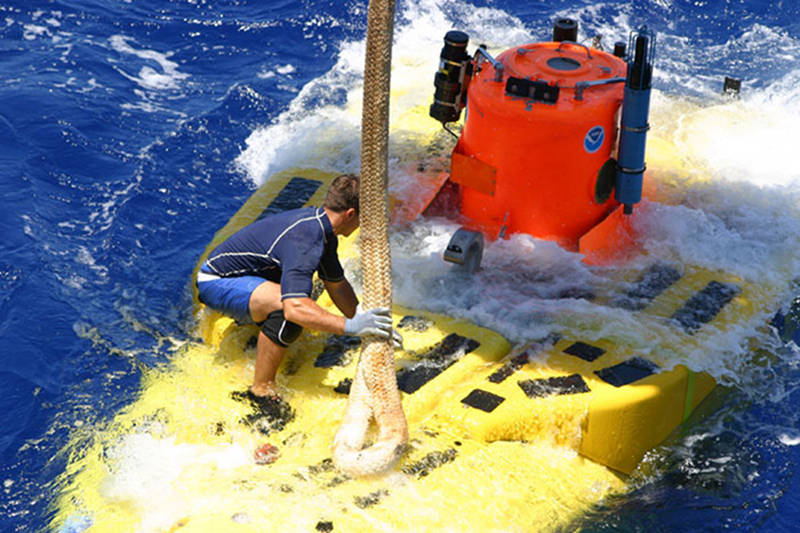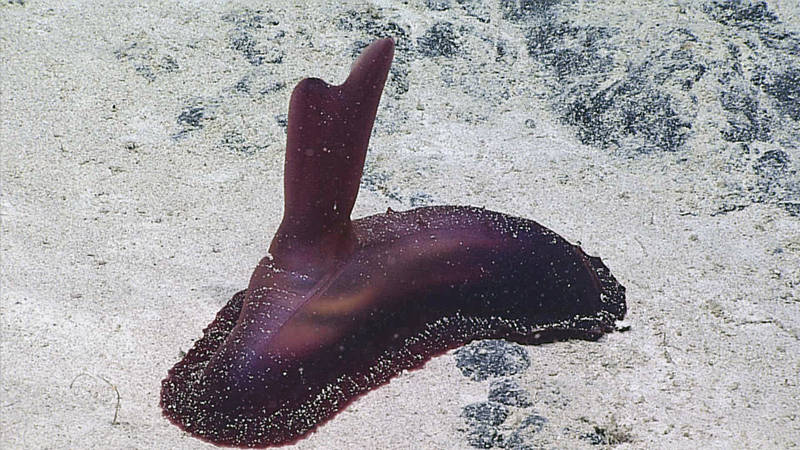
By Scott C. France - University of Louisiana at Lafayette
September 12, 2015

The black coral Stauropathes staurocrada, here being checked out by a seastar, (Pteraster reticulatus) at 1650 meters depth on North Maro Ridge, was first discovered off Penguin Bank, Hawaii, during a Pisces V dive in 1996. Image courtesy of the NOAA Office of Ocean Exploration and Research, 2015 Hohonu Moana. Download larger version (jpg, 1.4 MB).
'Ah, all things come to those who wait,'
(I say these words to make me glad),
But something answers soft and sad,
'They come, but often come too late.'Violet Fane (1843-1905) in her poem Tout vient qui sait attendre
I am thrilled to say that because of my participation on Leg 4 of the Hohonu Moana expedition I will not suffer the melancholy aspect of Violet Fane’s poem that some things “often come too late.” Twenty years ago my colleague, Dr. Lauren Mullineaux of the Woods Hole Oceanographic Institution, and I had planned an expedition to study deep-sea octocorals around Johnston Atoll. We had research funding and a research submersible – the Pisces V – provided by the Hawaii Undersea Research Laboratory (HURL) to help us learn more about the distribution and potential larval dispersal of selected species of corals (mainly bamboo corals).

The Pisces V submersible being recovered after a dive during a HURL expedition. Launching and recovery of submersibles and remotely operated vehicles are non-trivial operations that present safety hazards, particularly in poor weather conditions or rough seas. Image courtesy of the NOAA Office of Ocean Exploration and Research, 2015 Hohonu Moana. Download image (jpg, 103 KB).
But as the fates would have it, the timing was not quite right. HURL had recently acquired a new research vessel from which to deploy the Pisces V, and due to safety concerns of working in such remote areas with a yet-untested system, the decision was made to restrict the distance away from the home port in Oahu that we operated. So we had to remove the Johnston Atoll area dives from our plans.
When the time for our revised cruise to our secondary targets came around, severe weather issues then became a culprit. Heavy seas and strong winds are a serious problem for deploying expensive equipment, like submersibles and remotely operated vehicles, from a ship, and are a safety hazard for the people working on the deck. As for many an ocean-going scientist before us, we had to be nimble and revise our dive plans based on the best data at hand and predictions of where we would find the best sea state for operations.
In the end, we had six successful submersible dives between 400 – 1,350 meters depth to deep slopes and banks around Oahu and the big island of Hawaii, observing and collecting many priceless fragments of corals for our research – at least four of which were subsequently described as new species1. But we did not get to visit the more remote regions around Johnston Atoll.

A sea cucumber (Holothuroidea, Psychropotes sp.) seen at 2,690 meters depth in Maro Crater during Leg 2 of the Hohonu Moana expedition. Sea cucumbers are “deposit feeders,” animals that ingest mud and sand grains to extract the organic material that has accumulated on the bottom after sinking through the water column. Image courtesy of the NOAA Office of Ocean Exploration and Research, 2015 Hohonu Moana. Download larger version (jpg, 1.8 MB).
Now here I am, 20 years later, about to embark on an exploration of that very corner of the world using more sophisticated imaging and deep submersible technology than I could have imagined then. 'Ah, all things come to those who wait!'
Interestingly, the theme of “all things come to those who wait” applies also to many of the deep-sea animals we will surely encounter during this cruise. Sessile suspension feeders – in plain language, animals who are attached to the seafloor and who get their food by filtering the overlying water – and deposit feeders – those mobile animals who munch on the accumulated stuff that has been deposited from the water onto the seafloor – depend on food that is sinking through the water column. Ultimately, the source of this food is near the water surface where plant-like phytoplankton convert sunlight into biomolecules by photosynthesis. It can take weeks for these materials to sink through the water to reach the depths we’ll be exploring. So these deep-sea animals must effectively wait for what little food is available to sink down to their depths.
But our waiting is almost over; Leg 4 of Hohonu Moana is about to begin. Soon we’ll be exploring the deep waters around Johnston Atoll, shedding light onto the mobile and sessile animals who dwell in its darkness.
1Octocorals: Narella macrocalyx Cairns & Bayer, 2008, Paracalyptrophora hawaiinensis Cairns 2009; Black corals: Stauropathes staurocrada Opresko, 2002, Trissopathes pseudotristicha Opresko, 2003.